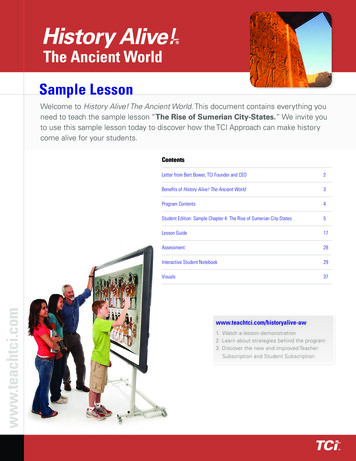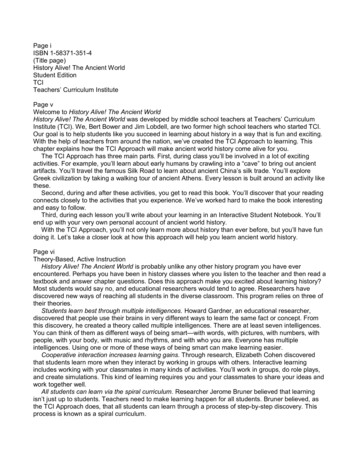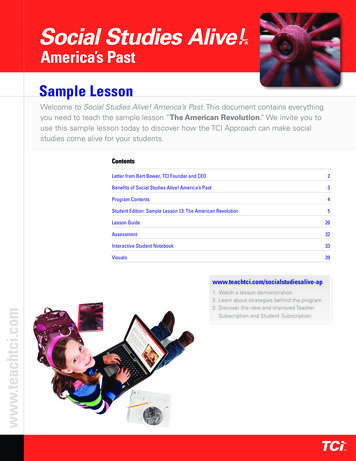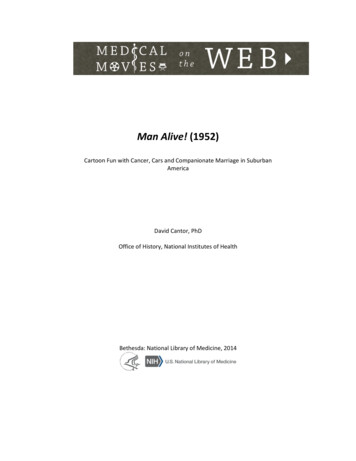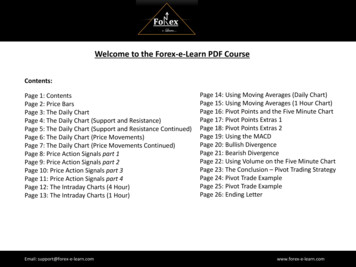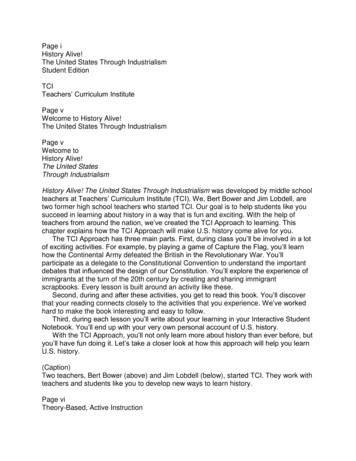
Transcription
Page iHistory Alive!The United States Through IndustrialismStudent EditionTCITeachers‘ Curriculum InstitutePage vWelcome to History Alive!The United States Through IndustrialismPage vWelcome toHistory Alive!The United StatesThrough IndustrialismHistory Alive! The United States Through Industrialism was developed by middle schoolteachers at Teachers‘ Curriculum Institute (TCI). We, Bert Bower and Jim Lobdell, aretwo former high school teachers who started TCI. Our goal is to help students like yousucceed in learning about history in a way that is fun and exciting. With the help ofteachers from around the nation, we‘ve created the TCI Approach to learning. Thischapter explains how the TCI Approach will make U.S. history come alive for you.The TCI Approach has three main parts. First, during class you‘ll be involved in a lotof exciting activities. For example, by playing a game of Capture the Flag, you‘ll learnhow the Continental Army defeated the British in the Revolutionary War. You‘llparticipate as a delegate to the Constitutional Convention to understand the importantdebates that influenced the design of our Constitution. You‘ll explore the experience ofimmigrants at the turn of the 20th century by creating and sharing immigrantscrapbooks. Every lesson is built around an activity like these.Second, during and after these activities, you get to read this book. You‘ll discoverthat your reading connects closely to the activities that you experience. We‘ve workedhard to make the book interesting and easy to follow.Third, during each lesson you‘ll write about your learning in your Interactive StudentNotebook. You‘ll end up with your very own personal account of U.S. history.With the TCI Approach, you‘ll not only learn more about history than ever before, butyou‘ll have fun doing it. Let‘s take a closer look at how this approach will help you learnU.S. history.(Caption)Two teachers, Bert Bower (above) and Jim Lobdell (below), started TCI. They work withteachers and students like you to develop new ways to learn history.Page viTheory-Based, Active Instruction
History Alive! The United States Through Industrialism is probably unlike any otherhistory program you have ever encountered. Perhaps you have been in history classeswhere you listen to the teacher and then read a textbook and answer chapter questions.Does this approach make you excited about learning history? Most students would sayno, and educational researchers would tend to agree. Researchers have discoverednew ways of reaching all students in the diverse classroom. This program relies onthree of their theories.Students learn best through multiple intelligences. Howard Gardner, an educationalresearcher, discovered that people use their brains in very different ways to learn thesame fact or concept. From this discovery, he created a theory called multipleintelligences. There are at least seven intelligences. You can think of them as differentways of being smart—with words, with pictures, with numbers, with people, with yourbody, with music and rhythms, and with who you are. Everyone has multipleintelligences. Using one or more of these ways of being smart can make learningeasier.Cooperative interaction increases learning gains. Through research, Elizabeth Cohendiscovered that students learn more when they interact by working with others ingroups. Interactive learning includes working with your classmates in many kinds ofactivities. You‘ll work in groups, do role plays, and create simulations. This kind oflearning requires you and your classmates to share your ideas and work together well.All students can learn via the spiral curriculum.Researcher Jerome Bruner believed that learning isn‘t just up to students. Teachersneed to make learning happen for allstudents. Bruner believed, as the TCI Approach does, that all students can learnthrough a process of step-by-step discovery. This process is known as a spiralcurriculum.These three theories are the foundation of the TCI Approach. Putting them intopractice in History Alive! The United States Through Industrialism gives you what youneed to succeed.(Caption)Researchers have found that students learn best when they are given the opportunity touse their multiple intelligences, work cooperatively with their peers, and build on whatthey know.Page viiStandards-Based ContentA lot of people care about what you are learning in history. These people include yourparents, your school administrators, your teachers, and even your state and nationalelected officials. In fact, if you‘re like students in most states, you take tests at the endof the year to measure your progress.Most end-of-year tests are based on standards. Standards are the key pieces ofinformation about history that elected officials think are important for you to remember.
When you read most standards, you might scratch your head and think, ―These seemreally hard to understand, and they‘re probably even harder to learn and remember.‖There‘s no need to worry about that with History Alive! The United States ThroughIndustrialism. Every lesson is based on standards. So every day, while you‘re havingfun learning U.S. history, you are also learning key standards.You‘ll be recording everything you learn in your Interactive Student Notebook. Whenit‘s time to prepare for tests, your notebook will make it easy to review all the standardsyou‘ve learned.In fact, students across the nation using the TCI Approach are getting better scoresthan ever on standardized tests. A big reason for this success is that the TCI Approachis based on interactive learning. That means you won‘t just read about history. You‘ll beactively involved in experiencing it and recording what you learn. Now let‘s look at whatyou‘ll do during each part of a lesson with the TCI Approach.(Caption)History Alive! The United States Through Industrialism has been carefully developed toprovide the information and learning you need to succeed on state tests.Preview AssignmentsWith the TCI Approach, learning starts even before you begin studying. Most of thelessons in History Alive! The United States Through Industrialism begin with a Previewassignment. Previews are short assignments that you complete in your InteractiveStudent Notebook. They allow you to make a personal connection to what you willstudy.After you complete a Preview assignment, your teacher will hold a brief classdiscussion. Several students will share their answers. Your teacher will then reveal howthe assignment ―previews‖ what is to come in the lesson.Here are some examples of the kinds of Preview assignments you will complete: Before learning about daily life in colonial America in Chapter 4, you will look at a setof statements about the colonies in a fictitious British tabloid newspaper. You‘ll becomea British reporter and travel to colonial America to evaluate the accuracy of theseclaims. Before learning about the Bill of Rights in Chapter 10, you will reflect on the powersgiven to parents in a ―Parents‘ Constitution.‖ You will determine if the powers should berestricted to protect the rights of children. Before learning about the lives of African Americans in the mid-1800s in Chapter 20,you will analyze a story quilt. You will use the quilt to find clues about the variedexperiences of African Americans during this time period. Before learning about the Civil War in Chapter 22, you will listen to two period songs.You will describe the mood and lyrics of each song as if you were a Confederate or aUnion soldier.Preview assignments like these will spark your interest and get you ready to tacklenew concepts. Next come the exciting activities that make up the heart of each lesson.As you‘re about to see, these activities draw on many ways of being smart—our multipleintelligences.
(Caption)Preview assignments like the ones shown here help introduce you to new topics.Page ixMultiple Intelligence Teaching StrategiesThe teaching strategies in the TCI Approach are based on hands-on learning. Everylesson in History Alive! The United States Through Industrialism is built around a funand exciting activity. We mentioned some examples earlier. Here are some other thingsyou and your classmates will do to experience U.S. history: For Chapter 3, you‘ll prepare a booth for a colonial fair to see the similarities anddifferences between the New England, Middle, and Southern colonies. For Chapter 16, you‘ll become groups of people traveling to the West in the 1800s,bringing to life the challenges and successes of your move westward. For Chapter 25, you‘ll pretend to be workers in a garment factory, experiencing life onthe assembly line.Activities like these will challenge you to use your multiple intelligences. Think abouttimes when learning new things has been easier for you. Were you looking at picturesabout the new ideas? Were you writing about them? Does acting out an event help youto better understand what happened? Studying history is a lot easier and more funwhen you learn new ideas in ways that best suit your learning styles. Here‘s a list ofseven different intelligences: Linguistic (word smart) Logical-mathematical (number/reasoning smart) Spatial (picture smart) Body-kinesthetic (body smart) Musical (music smart) Interpersonal (people smart) Intrapersonal (self smart)While you‘re engaged in fun and exciting activities, you‘ll also be reading this book tolearn more about U.S. history. The next page explains why this book is so easy to read.(Caption)Using your multiple intelligences helps you learn and remember what you study.Page xConsiderate TextThe TCI Approach is all about being successful and having fun while you learn. You‘reabout to discover that History Alive! The United States Through Industrialism isinteresting to read and easy to understand. That‘s because this book is ―reader friendly,‖which is another of saying that it makes readers want to read it. Some people call thisconsiderate text. The writers of this book considered your needs as a reader and madesure you would have fun reading.Here are some of the ways this book is considerate of all levels of readers: Each chapter is organized around key concepts. The summary section reminds you ofthe big ideas in the chapter.
Each chapter begins with a graphic organizer—a picture that represents the mainideas of the chapter. The graphic organizer also appears in the Reading Notes in yourInteractive Student Notebook. It will help you remember key ideas long after you‘ve readthe chapter. Short chapters make it easier for you to understand and remember what each one isabout. Each section has a clear focus and a subtitle that provides an outline for your reading.Research shows that presenting new information in easy-to-manage chunks makes iteasier to understand. Important new words are in bold teal-colored type. These words are defined in themargins and in the Glossary at the back of the book. Photos and illustrations provide additional information about the topic on the page. Agreat way to check your understanding is to ask yourself, ―How does this picture showwhat I just read?‖Most importantly, History Alive! The United States Through Industrialism is asexciting to read as a good story. The next section explains a special way of taking notesthat will help you remember what you read.(Caption)You‘ll use History Alive! The United States Through Industrialism during classroomactivities. You‘ll be turning to it over and over again to find the information you need toknow.Page xiGraphically Organized Reading NotesNote taking is very important in the TCI Approach. As you read this book, you‘llcomplete Reading Notes in your Interactive Student Notebook. You‘ll answer importantquestions, find main ideas, and connect new ideas to what you already know.Your Reading Notes will leave you with a picture in your mind of each chapter‘s keyideas. The graphic organizers at the start of each chapter will be a visual reminder ofwhat you read. In your Reading Notes, you‘ll use those same graphic organizers to helpyou record key ideas. For example, in Chapter 6, you‘ll use a visual metaphor of a ropetying the American colonies to Britain. You‘ll take notes on the rope‘s unraveling strandsto record the weakening ties that led to the Declaration of Independence. For Chapter15, you will take notes on map of the United States. You will trace and annotate newboundaries to follow the country‘s expansion across the continent. For Chapter 18,you‘ll take notes on signs carried by people demonstrating for change. The signsrepresent the different reform movements of the mid-19th century.Completing your Reading Notes will help you study in two ways. First, it willencourage you to think carefully about what you read. Second, recording key ideas willhelp you remember them for a long time.There‘s one more part of the TCI Approach that will help you remember theimportant ideas you are learning. Read the next page to find out.(Caption)
You‘ll record key ideas on the Reading Notes pages in your Interactive StudentNotebook. This will help you remember what you learned long after the lesson is over.Page xiiProcessing AssignmentsAt the end of each lesson, you‘ll complete a Processing assignment in your InteractiveStudent Notebook. Here you‘ll show that you understand the key concepts of thelesson.These pages encourage you to relate ideas to one another. You‘ll make connectionsbetween the past and present. You‘ll show your understanding of concepts by creatingillustrations, diagrams, flowcharts, poetry, and cartoons. As one student said, ―It‘s reallycool to have a place in our notebooks where we can record our own ideas. It makeslearning history a lot more fun.‖Here are some examples of the kinds of Processing assignments you‘ll complete: In Chapter 5, you will learn about the tensions between the colonies and Britain from1763 to 1775. In the Processing assignment, you‘ll write a dialogue between the twosides. In Chapter 14, you will assess the presidency of Andrew Jackson. In the Processingassignment, you‘ll design a hero‘s commemorative plaque to highlight his positivecontributions and a Wanted poster to show his negative impact. In Chapter 28, you will analyze early 20th-century political cartoons to learn about U.S.expansionism. In the Processing assignment, you‘ll create your own political cartoon toshow your support or opposition to U.S. involvement in World War I.Students across the country report that their Processing assignments have helpedthem understand and remember what they have learned. As a result, they are earninghigher test scores.(Caption)In Processing assignments, you‘ll show that you understand the new ideas of thelesson.Page xiiiMultiple Intelligence AssessmentsDo you dread taking chapter and unit tests? If so, maybe you feel that most tests don‘tlet you show what you‘ve learned. The tests for History Alive! The United StatesThrough Industrialism are different. They let you show how well you understand eachlesson‘s key ideas.These tests also allow you to use your multiple intelligences. Each test has some ofthe usual multiple-choice questions. These will help prepare you for taking more formaltests. But other parts of the assessments will challenge you to use more than just your―word smart‖ intelligence. They‘ll give you a chance to shine if you are good in otherareas, such as reading maps, using charts and graphs, drawing, understanding music,or analyzing historical paintings. You may also be asked to show how well you read.You‘ll be invited to express your ideas and your understanding of historical events inwriting, too.
The secret to doing well on tests is preparation. You have the perfect tool for thispurpose: your Interactive Student Notebook. Right there on those pages are your notesabout all the key ideas in each chapter. Students who study their Reading Notes andProcessing assignments before a test usually earn good test scores.Success on tests is important, but the most important thing of all is learning. We‘vedesigned our tests not justto assess your understanding but to help you remember key ideas. That‘s becausethe lessons you learn from U.S. history can help you make sense of your world andguide your future decisions. We hope that what you learn in History Alive! The UnitedStates Through Industrialism will remain with you for years to come.(Caption)Your teacher may give you test pages to complete at the end of a lesson. These testsinclude questions with multiple-choice answers as well as questions that let you draw orwrite your answers.Page xivContentsChapter 1The Native Americans1Meet the Native Americans who lived in different regions of North America. Discoverhow the different environments affected these original settlers.Chapter 2European Exploration and Settlement 17Read about the European countries that competed for control of the New World and itsriches. Learn what devastating effects their arrival had on the native population.Chapter 3The English Colonies in America 35Travel with the first English settlers who came to start a new life in America. Considerthe advantages and disadvantages of life in the New England, Middle, and SouthernColonies.Chapter 4Life in the Colonies 49Experience the joys and hardships of daily life for the American colonists, their servants,and slaves. Learn about their work, their pleasures, their food, their religion, and theirschooling.Chapter 5Toward Independence63Discover what happened as tensions grew between the colonists and their governmentin far-off England. Meet the people who would rather risk their lives than give up theirrights.
Page xvChapter 6The Declaration of Independence 79Examine the events that led the colonists to declare independence. Witness the bravemen who created a document that changed the world.Chapter 7The American Revolution 87Relive the challenges faced by poorly trained and ill-equipped solders, locked in a waragainst the most powerful nation in the world. Learn how the colonies won therevolution and their independence from Great Britain.Chapter 8Creating the Constitution 103Share the frustrations of the delegates to the Constitutional Convention as theystruggled to organize a new government. Recognize the compromises they made forthe sake of presenting a united plan.Chapter 9The Constitution: A More Perfect Union 119Why has the Constitution endured for more than 200 years of extreme social change?Examine this remarkable document that describes the organization and powers of thenational government and its unique system of checks and balances.Chapter 10The Bill of Rights 133Explore the power of the first ten amendments to the Constitution. Learn how they areused by the Supreme Court to protect the basic freedoms we enjoy in our daily lives.Page xviChapter 11Political Developments in the Early Republic 145Compare the two rivals in the election of 1800—Hamilton and Jefferson. Note how theiropposing views gave rise to the country‘s first political parties and led to a new way ofelecting the president.Chapter 12Foreign Affairs in the Young Nation161Follow the foreign policy debates as the young America faces threats from powerfulEuropean nations. Learn which presidents were willing to risk war and which preferredto keep their country at peace.Chapter 13A Growing Sense of Nationhood 175
Learn how the United States developed a national identity in the first half of the 19thcentury. Take a look at the politics, art, music, and literature that helped define what itmeant to be an American.Chapter 14Andrew Jackson and the Growth of American Democracy185Evaluate Andrew Jackson, one of the nation‘s most colorful presidents, through theeyes of his contemporaries. Understand why some thought he was a villain and othersconsidered him a hero.Page xviiChapter 15Manifest Destiny and the Growing Nation197Trace the expansion of America across the continent. Discover why many Americansbelieved it was both their right and their duty to spread their way of life into the West.Chapter 16Life in the West211Join the explorers, the trappers, the missionaries, and other pioneers on their difficultjourney to settle the rugged West. Discover the unique contributions each group madeto American culture.Chapter 17Mexicano Contributions to the Southwest229Recognize the many Mexicano innovations adopted by Anglos. Appreciate theircontributions that enabled settlers to prosper in the hot, dry climate of the Southwest.Chapter 18An Era of Reform 241Find out about the efforts of American reformers in such causes as ending slavery,promoting women‘s rights, and improving education. Judge the progress women havemade toward full equality.Chapter 19The Worlds of North and South 253Step back in time to experience life in a northern city and on a southern plantation.Explore the differences that would ultimately shatter the unity of the country.Page xviiiChapter 20African Americans at Mid-Century 269Share the misery and admire the courage of black Americans living as slaves. Learnabout their struggle to escape racism and discrimination.Chapter 21A Dividing Nation285
Discover the deep divisions over slavery that would threaten to tear the country apart.Join the search for compromises on the issues that divided the nation.Chapter 22The Civil War303Visit battlegrounds to relive the Civil War. Face the terrors and hardships of those whosuffered through America‘s bloodiest war.Chapter 23The Reconstruction Era323Track the progress of African Americans toward full citizenship following the Civil War.Feel the disappointment and bitterness of former slaves who lost their newly gainedrights.Chapter 24Tensions in the West337Follow the groups that swept across the West after the Civil War. Observe their clasheswith the Native Americans and consider their impact on the West‘s native peoples.Page xixChapter 25The Rise of Industry 353Learn how the rise of big business changed American life. Explore the innovations thattransformed society, and witness the benefits and the abuses of industrialization.Chapter 26The Great Wave of Immigration 371Step off a steamship or cross the border with some of the many immigrants fromEurope, Asia, and Mexico. Learn about their hopes, their struggles, and theirdisappointments.Chapter 27The Progressive Era385Investigate the problems in America and discover how social leaders proposed to dealwith them. Understand that while the ―Progressives‖ fought for many different causes,all sought a better American society.Chapter 28America Becomes a World Power 399Revisit America as the 20th century begins, and learn how expansionists moved toextend the nation‘s power across the Western Hemisphere and around the world.Chapter 29Linking Past to Present417
Consider the tremendous changes in social and economic conditions in the UnitedStates since 1914. Recognize the role that dedicated individuals have played and willalways play in shaping the world around them.Resources425Page 1Chapter 1The Native Americans(Caption)What materials were used to make these people‘s clothes?What are these people trading?What materials were used to make these houses?1.1 IntroductionAs a cold winter wind howls outside, the children huddle under thick fur blankets. They listen totheir grandmother‘s soothing voice. ―In the beginning there was the Great Spirit,‖ Grandmotherbegins, ―who ruled over a world of sky and water.‖ Then the Great Spirit, says Grandmother,created land, plants, and animals. Finally, from living wood, the Great Spirit carved people forthe new world.These Abenaki children of New England are learning how their people began. Most groupshave beliefs about where they came from. You may have heard stories about how your ownrelatives first arrived in America. But do you know where your ancestors were living 10,000years ago?Only if you are Native American did you have relatives in America that long ago. Europeansand other groups did not start arriving until a little more than 500 years ago. For thousands ofyears, these First People had the American continents to themselves. In this chapter, you willlearn about these resourceful people and the creative ways they developed to live in tune withthe natural world.Even today, scientists are trying to find out more about the first Americans. These earlypeople left few written records to tell us what their lives were like, so researchers study otheritems they left behind. What has survived? Not much. A few animal and human bones, somestone and metal tools, bits of pottery. Like detectives, scientists sift through these clues, tryingto imagine how these people lived and how their lives changed over time. When scientists find anew object, they try to figure out whether it supports their current ideas or suggests new ones.In your lifetime, scientists will probably learn much more about the first Americans and mayrevise many of their conclusions. This chapter tells these people‘s stories as we know themtoday.(Caption)Graphic Organizer: Map of Cultural RegionsYou will use this map to learn about the adaptations made by Native Americans living in eightcultural regions.Page 21.2 Migration Routes of the First AmericansThe first Americans probably migrated on foot from Siberia, in Asia, to present-day Alaska.Today, Alaska and Asia are separated by a strip of ocean called the Bering Strait. But there wasa time when a land bridge connected them.
Across a Land Bridge About 30,000 years ago, the most recent Ice Age began. Astemperatures fell, much of the earth was covered by glaciers, sheets of ice up to a mile thick.With water locked up in the glaciers, the level of the oceans dropped 200 feet. This exposed awide bridge of land between Asia and North America that scientists call Beringia.In the summer, Beringia‘s grasslands attracted large Asian mammals, such as mammoths,long-haired cousins of the elephant. Over thousands of years, the animals slowly spreadeastward. Generations of Siberian hunter families followed. Armed with only stone-tippedspears, they killed these huge, powerful animals for food. Eventually, perhaps between 10,000and 20,000 years ago, some of them reached America. Other migrants may have traveled alongthe coast of Beringia by boat to catch fish, seals, and other marine mammals.Migrating East and South Once in America, hunters followed the animals south, where springbrought fresh grasses. Then, about 10,000 years ago, the earth warmed up again. As theglaciers melted and the oceans rose, the land bridge disappeared. Mammoths and othertraditional prey began to die off, perhaps from disease, over hunting, or the change in theclimate.Native Americans now had to find new sources of food and new materials for clothing andshelter. So they became hunter-gatherers, catching smaller animals, fishing more, andcollecting edible plants and seeds. Over thousands of years, they spread across the twoAmerican continents, from the Pacific to the Atlantic, and from Alaska all the way to the tip ofSouth America.(Caption)Scientists believe that the first Americans migrated from Siberia to Alaska across a land bridgecalled Beringia. These people were following mammoths and other prey that moved east insearch of grazing land.(Vocabulary)migrate To move from one place and establish a home in a new place. A move of a largenumber of people is called a migration, and the people who move are called migrants. Someanimals also migrate, usually with the seasons.(Map Title)Migrating Routes of the First AmericansPage 31.3 Native Americans Adapt to the EnvironmentNative Americans lived in a variety of places, from snowy forests to dry deserts and vastgrasslands. Each of these kinds of places is an environment. An environment includeseverything that surrounds us—land, water, animals, and plants. Each environment also has aclimate, or long-term weather pattern. Groups of Native Americans survived by adapting, orchanging, their style of living to suit each environment, its climate, and its natural resources.Using Natural Resources Native Americans learned to use the natural resources in theirenvironments for food, clothing, and shelter. In the frigid regions of the far north, earlyAmericans survived by hunting caribou in the summer and sea mammals in the winter. Theyfashioned warm, hooded clothing from animal skins. To avoid being blinded by the glare of thesun shining on snow, they made goggles out of bone with slits to see through.
The people of the north lived most of the year in houses made from driftwood and animalskins. In winter, hunters built temporary shelters called iglus out of blocks of snow.In warmer climates, early Americans gathered wild plants. Then, about 7,000 years ago, theylearned to raise crops such as squash, chili peppers, beans, and corn. Growing their own foodenabled them to settle in one place instead of following animals or searching for edible plants inthe wild. These early farmers built the first villages and towns in America.Native American Cultural Regions Over generations, groups of Native Americans developedtheir own cultures, or ways of life. Many became part of larger groupings that were looselyorganized under common leaders.Groups living in the same type of environment often adapted in similar ways. Forest dwellersoften lived in houses covered with tree bark, while many desert peoples made shelters out ofbranches covered with brush.Using such artifacts (items made by people), historians have grouped Native Americanpeoples into cultural regions. A cultural region is made up of people who share a similarlanguage and way of life.By the 1400s, between one and two million Native Americans lived in ten major culturalregions north of Mexico. Later in this chapter, you will take a close-up look at eight of theseregions. They include the Northwest Coast, California, the Great Basin, the Plateau, theSouthwest, the Great Plains, the Eastern Woodlands, and the Southeast.(Caption)The tents i
where you listen to the teacher and then read a textbook and answer chapter questions. Does this approach make you excited about learning history? Most students would say no, and educational researchers would tend to agree. Researchers have discovered new ways of reaching all students in the diverse classroom. This program relies on
